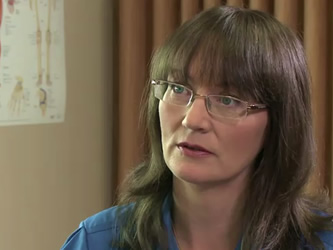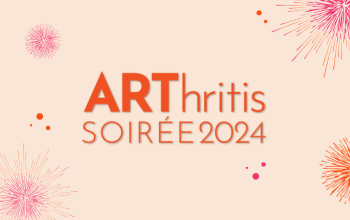The Arthritis Newsletter
Summer 2012Dr. Jolanda Cibere: Specializing in the Research of Osteoarthritis
 Dr. Jolanda Cibere is a Research Scientist at the Arthritis Research Centre of Canada and an Associate Professor at UBC.
Dr. Jolanda Cibere is a Research Scientist at the Arthritis Research Centre of Canada and an Associate Professor at UBC.
CAB members attending the Canadian Rheumatology Association’s 2012 Conference in March, were delighted to see Dr. Jolanda Cibere receive the Young Investigator Award. The award recognizes a young Canadian investigator who has contributed significant and original research in rheumatology. She is also the recipient of the Clinician Scientist Phase II Scholar Award from the Canadian Institutes of Health Research; the Young Innovator Award from the Federal Networks of Centres of Excellence; the UBC Departmental Faculty and the J. W. McConnell Family Foundation Scholar Awards; and, most recently, she was awarded an Arthritis Society Investigator Award.
As a recognized leading scientist in the field of osteoarthritis, it was recently our pleasure to interview Dr. Cibere.
Dr. Cibere, how long have you been at the Arthritis Research Centre of Canada?
I have been at the Arthritis Research Centre of Canada since its inception in 2000. I was a trainee at that time, conducting my doctoral studies in Health Care and Epidemiology at the University of British Columbia.
Why did you decide to focus your research on Osteoarthritis?
Osteoarthritis is a huge problem with a high prevalence of the disease, compounded by the ageing of the population. We know that we are going to have to deal with a lot of people with osteoarthritis: this trend has already begun, but it will manifest even more starkly in the future. Despite its importance, I thought that osteoarthritis was rather neglected at the time I started my research, and there was a particular shortage of research focused on early disease.
What is the joint most commonly affected by Osteoarthritis?
The hands are most commonly affected, although the knee is also very common and leads to most disability.
Is there a way to predict the progression rate of knee osteoarthritis?
We are starting to develop a tool to help predict the progression of knee osteoarthritis. We do know that those with more severe x-ray abnormalities and those with weak thigh muscles are more likely to progress.
What makes your Knee Osteoarthritis research studies unique?
We have included very broad assessments in our knee study, such as detailed clinical testing with questionnaires, detailed knee examination, x-ray and MRI (Magnetic Resonance Imaging). MRI is uniquely suited to evaluate all the abnormalities in the joint and it can assess the arthritis in much more detail and much earlier than an x-ray can. We have also included so called ‘biomarker tests’ in this study, which are measured in the blood or urine. We have shown that some of these tests are indeed helpful for early diagnosis.
The people who participated in this study were randomly selected. This is helpful to ensure that the results are generalizable. We have also conducted follow-up assessments at 3 years, and are in the process of completing the 6-year follow-up. Evaluating osteoarthritis over the long-term is essential, since this is a disease that progresses over many years.
We understand that you have developed a standardized knee examination that has been adopted by national studies in the USA and the UK. Would a family physician be able to diagnose knee osteoarthritis using this standard knee examination?
Yes, the standardized knee exam is easy to use in clinical practice and there are three knee exam tests that help with early diagnosis. With the help of the late Leslie Nielsen, we have produced a video to demonstrate the pertinent questions and knee exams to family doctors and other health care practitioners for diagnosis of knee osteoarthritis.
Are there specific activities or exercises that should be avoided when attempting to cope with the early signs of knee Osteoarthritis?
I tell patients to avoid full squatting and kneeling, as these activities can aggravate pain and put a lot of pressure on the joint. Patients should consult with a physiotherapist to start an exercise program.
Are there specific activities or exercises that can be done to help manage knee Osteoarthritis pain?
Knee and hip muscle strengthening exercises are recommended to help reduce pain. Weight loss is helpful in knee osteoarthritis and is best achieved by a combination of dieting with exercising. Patients should consult with a physiotherapist to start an exercise program.
Is Osteoarthritis a genetic disease?
Both genetics and environmental causes play a role in the development of osteoarthritis in a complex way that we do not fully understand yet.
Is there a resource you would recommend to people living with Osteoarthritis?
Education is crucial. Patients should learn as much about osteoarthritis as they can. Physiotherapy is useful for an exercise program, for use of a cane or other walking aids, and for other modalities of treatment. The occupational therapist can help with shoe insoles which can be helpful to relieve knee pain. Water exercise programs are available at community centres.
How is your research helping to get closer to finding answers to preventing, detecting and curing Osteoarthritis?
We have developed a tool to help diagnose osteoarthritis, including those at early stage of disease. The next step is to develop a tool to help identify patients at risk of progression. We can then do controlled studies, where we can test whether our current treatments are helpful in reducing the progression of disease in those at highest risk. The hope is that in the future, new drug treatments will be developed to help slow down osteoarthritis.
Thank you very much, Dr. Cibere. We are delighted to be able to invite our readers to watch your video with the late Canadian actor, Leslie Nielsen HERE.





















































